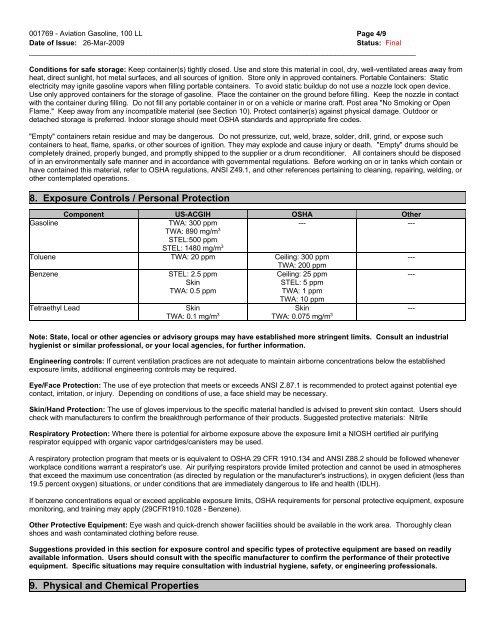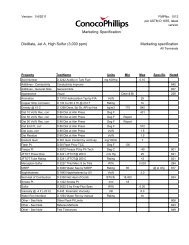COP Fuels Tests DH - Phillips 66 Aviation
COP Fuels Tests DH - Phillips 66 Aviation
COP Fuels Tests DH - Phillips 66 Aviation
You also want an ePaper? Increase the reach of your titles
YUMPU automatically turns print PDFs into web optimized ePapers that Google loves.
001769 - <strong>Aviation</strong> Gasoline, 100 LL<br />
Date of Issue: 26-Mar-2009<br />
________________________________________________________________________________________________<br />
Conditions for safe storage: Keep container(s) tightly closed. Use and store this material in cool, dry, well-ventilated areas away from<br />
heat, direct sunlight, hot metal surfaces, and all sources of ignition. Store only in approved containers. Portable Containers: Static<br />
electricity may ignite gasoline vapors when filling portable containers. To avoid static buildup do not use a nozzle lock open device.<br />
Use only approved containers for the storage of gasoline. Place the container on the ground before filling. Keep the nozzle in contact<br />
with the container during filling. Do not fill any portable container in or on a vehicle or marine craft. Post area "No Smoking or Open<br />
Flame." Keep away from any incompatible material (see Section 10). Protect container(s) against physical damage. Outdoor or<br />
detached storage is preferred. Indoor storage should meet OSHA standards and appropriate fire codes.<br />
"Empty" containers retain residue and may be dangerous. Do not pressurize, cut, weld, braze, solder, drill, grind, or expose such<br />
containers to heat, flame, sparks, or other sources of ignition. They may explode and cause injury or death. "Empty" drums should be<br />
completely drained, properly bunged, and promptly shipped to the supplier or a drum reconditioner. All containers should be disposed<br />
of in an environmentally safe manner and in accordance with governmental regulations. Before working on or in tanks which contain or<br />
have contained this material, refer to OSHA regulations, ANSI Z49.1, and other references pertaining to cleaning, repairing, welding, or<br />
other contemplated operations.<br />
8. Exposure Controls / Personal Protection<br />
Component US-ACGIH OSHA Other<br />
Gasoline TWA: 300 ppm<br />
TWA: 890 mg/m3 STEL:500 ppm<br />
STEL: 1480 mg/m3 --- ---<br />
Toluene TWA: 20 ppm Ceiling: 300 ppm<br />
TWA: 200 ppm<br />
---<br />
Benzene STEL: 2.5 ppm<br />
Ceiling: 25 ppm<br />
---<br />
Skin<br />
STEL: 5 ppm<br />
TWA: 0.5 ppm<br />
TWA: 1 ppm<br />
TWA: 10 ppm<br />
Tetraethyl Lead Skin<br />
TWA: 0.1 mg/m3 Skin<br />
TWA: 0.075 mg/m3 ---<br />
Note: State, local or other agencies or advisory groups may have established more stringent limits. Consult an industrial<br />
hygienist or similar professional, or your local agencies, for further information.<br />
Engineering controls: If current ventilation practices are not adequate to maintain airborne concentrations below the established<br />
exposure limits, additional engineering controls may be required.<br />
Eye/Face Protection: The use of eye protection that meets or exceeds ANSI Z.87.1 is recommended to protect against potential eye<br />
contact, irritation, or injury. Depending on conditions of use, a face shield may be necessary.<br />
Skin/Hand Protection: The use of gloves impervious to the specific material handled is advised to prevent skin contact. Users should<br />
check with manufacturers to confirm the breakthrough performance of their products. Suggested protective materials: Nitrile<br />
Respiratory Protection: Where there is potential for airborne exposure above the exposure limit a NIOSH certified air purifying<br />
respirator equipped with organic vapor cartridges/canisters may be used.<br />
A respiratory protection program that meets or is equivalent to OSHA 29 CFR 1910.134 and ANSI Z88.2 should be followed whenever<br />
workplace conditions warrant a respirator's use. Air purifying respirators provide limited protection and cannot be used in atmospheres<br />
that exceed the maximum use concentration (as directed by regulation or the manufacturer's instructions), in oxygen deficient (less than<br />
19.5 percent oxygen) situations, or under conditions that are immediately dangerous to life and health (IDLH).<br />
If benzene concentrations equal or exceed applicable exposure limits, OSHA requirements for personal protective equipment, exposure<br />
monitoring, and training may apply (29CFR1910.1028 - Benzene).<br />
Other Protective Equipment: Eye wash and quick-drench shower facilities should be available in the work area. Thoroughly clean<br />
shoes and wash contaminated clothing before reuse.<br />
Suggestions provided in this section for exposure control and specific types of protective equipment are based on readily<br />
available information. Users should consult with the specific manufacturer to confirm the performance of their protective<br />
equipment. Specific situations may require consultation with industrial hygiene, safety, or engineering professionals.<br />
9. Physical and Chemical Properties<br />
Page 4/9<br />
Status: Final




